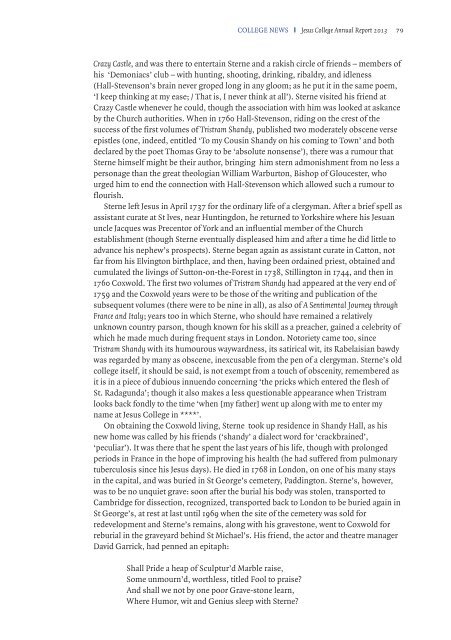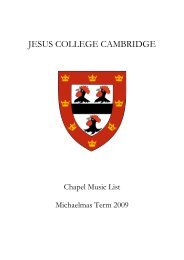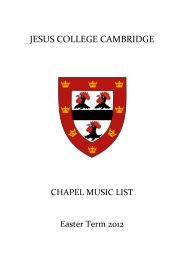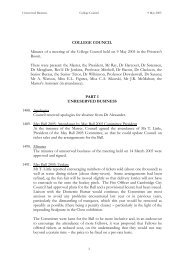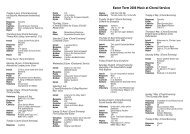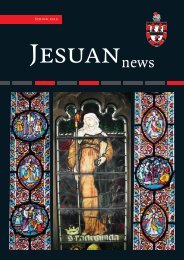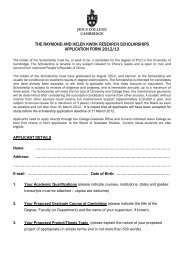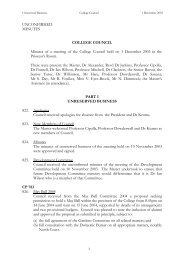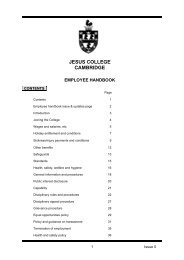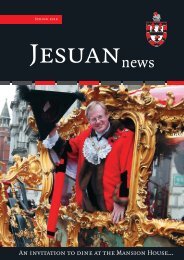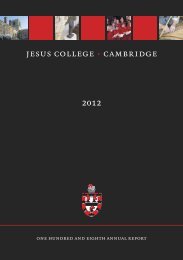2013 Annual Report - Jesus College - University of Cambridge
2013 Annual Report - Jesus College - University of Cambridge
2013 Annual Report - Jesus College - University of Cambridge
You also want an ePaper? Increase the reach of your titles
YUMPU automatically turns print PDFs into web optimized ePapers that Google loves.
COLLEGE NEWS I <strong>Jesus</strong> <strong>College</strong> <strong>Annual</strong> <strong>Report</strong> <strong>2013</strong> 79<br />
Crazy Castle, and was there to entertain Sterne and a rakish circle <strong>of</strong> friends – members <strong>of</strong><br />
his ‘Demoniacs’ club – with hunting, shooting, drinking, ribaldry, and idleness<br />
(Hall-Stevenson’s brain never groped long in any gloom; as he put it in the same poem,<br />
‘I keep thinking at my ease; / That is, I never think at all’). Sterne visited his friend at<br />
Crazy Castle whenever he could, though the association with him was looked at askance<br />
by the Church authorities. When in 1760 Hall-Stevenson, riding on the crest <strong>of</strong> the<br />
success <strong>of</strong> the first volumes <strong>of</strong> Tristram Shandy, published two moderately obscene verse<br />
epistles (one, indeed, entitled ‘To my Cousin Shandy on his coming to Town’ and both<br />
declared by the poet Thomas Gray to be ‘absolute nonsense’), there was a rumour that<br />
Sterne himself might be their author, bringing him stern admonishment from no less a<br />
personage than the great theologian William Warburton, Bishop <strong>of</strong> Gloucester, who<br />
urged him to end the connection with Hall-Stevenson which allowed such a rumour to<br />
flourish.<br />
Sterne left <strong>Jesus</strong> in April 1737 for the ordinary life <strong>of</strong> a clergyman. After a brief spell as<br />
assistant curate at St Ives, near Huntingdon, he returned to Yorkshire where his Jesuan<br />
uncle Jacques was Precentor <strong>of</strong> York and an influential member <strong>of</strong> the Church<br />
establishment (though Sterne eventually displeased him and after a time he did little to<br />
advance his nephew’s prospects). Sterne began again as assistant curate in Catton, not<br />
far from his Elvington birthplace, and then, having been ordained priest, obtained and<br />
cumulated the livings <strong>of</strong> Sutton-on-the-Forest in 1738, Stillington in 1744, and then in<br />
1760 Coxwold. The first two volumes <strong>of</strong> Tristram Shandy had appeared at the very end <strong>of</strong><br />
1759 and the Coxwold years were to be those <strong>of</strong> the writing and publication <strong>of</strong> the<br />
subsequent volumes (there were to be nine in all), as also <strong>of</strong> A Sentimental Journey through<br />
France and Italy; years too in which Sterne, who should have remained a relatively<br />
unknown country parson, though known for his skill as a preacher, gained a celebrity <strong>of</strong><br />
which he made much during frequent stays in London. Notoriety came too, since<br />
Tristram Shandy with its humourous waywardness, its satirical wit, its Rabelaisian bawdy<br />
was regarded by many as obscene, inexcusable from the pen <strong>of</strong> a clergyman. Sterne’s old<br />
college itself, it should be said, is not exempt from a touch <strong>of</strong> obscenity, remembered as<br />
it is in a piece <strong>of</strong> dubious innuendo concerning ‘the pricks which entered the flesh <strong>of</strong><br />
St. Radagunda’; though it also makes a less questionable appearance when Tristram<br />
looks back fondly to the time ‘when [my father] went up along with me to enter my<br />
name at <strong>Jesus</strong> <strong>College</strong> in ****’.<br />
On obtaining the Coxwold living, Sterne took up residence in Shandy Hall, as his<br />
new home was called by his friends (‘shandy’ a dialect word for ‘crackbrained’,<br />
‘peculiar’). It was there that he spent the last years <strong>of</strong> his life, though with prolonged<br />
periods in France in the hope <strong>of</strong> improving his health (he had suffered from pulmonary<br />
tuberculosis since his <strong>Jesus</strong> days). He died in 1768 in London, on one <strong>of</strong> his many stays<br />
in the capital, and was buried in St George’s cemetery, Paddington. Sterne’s, however,<br />
was to be no unquiet grave: soon after the burial his body was stolen, transported to<br />
<strong>Cambridge</strong> for dissection, recognized, transported back to London to be buried again in<br />
St George’s, at rest at last until 1969 when the site <strong>of</strong> the cemetery was sold for<br />
redevelopment and Sterne’s remains, along with his gravestone, went to Coxwold for<br />
reburial in the graveyard behind St Michael’s. His friend, the actor and theatre manager<br />
David Garrick, had penned an epitaph:<br />
Shall Pride a heap <strong>of</strong> Sculptur’d Marble raise,<br />
Some unmourn’d, worthless, titled Fool to praise?<br />
And shall we not by one poor Grave-stone learn,<br />
Where Humor, wit and Genius sleep with Sterne?


